

Palomar. The associations, the discoveries. There may never be another instrument which so captures the public fascination as the Palomar 200-inch telescope (nowadays that's 5 meters). From Hubble's inital plates, through much of the work on the distance-scale problem in the 1960s and 1970s, to quasar searches, to finding high-redshift galaxy clusters, this has been a vastly productive instrument. Now eclipsed by the Keck instruments (co-operated by Caltech, Palomar's owner), it still continues in active use for both research and instrument development. The telescope now stands as a fascinating mix of old (the Art Deco horns on each side of the dome slit, solely decorative) and new (optical bench on the side of the tube to pipe a laser for adaptive optics). I spent a while wandering around the dome pondering the solidity as well as quality of the telescope - this was built by my grandparents' generation!
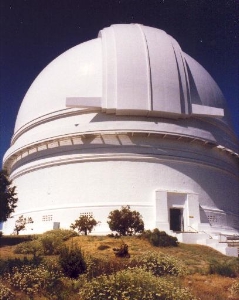
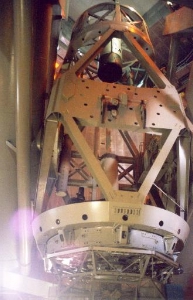
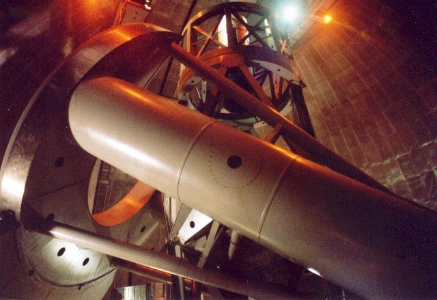
I had the rare chance to use the Hale telescope in a set of observations supporting a GALEX program, since coinvestigator Scott Chapman was at Caltech (at which point the Palomar page was promoted from the "tourist" section of this site). This became a more interesting experience than I anticipated, since a failure in a supporting rail meant that we couldn't point the dome toward any of our targets for half of the observing run. Until a specialist welder from Seattle finished his repairs, we could look only at things which were visible with the dome stuck pointing toward the northeast. My instructions from the site director for the first two nights were "have fun and try to do something interesting". Wherever Hubble is buried, there were vibrations from underground... Here are some art shots, snippets from the 24-arcminute field covered by the 6-CCD mosaic camera. The Crescent Nebula, NGC 6888, is a windblown bubble produced by the fierce wind from its central Wolf-Rayet star. It spans most of the mosaic field (shown here in a single exposure before processing to fill in the gaps with other exposures).
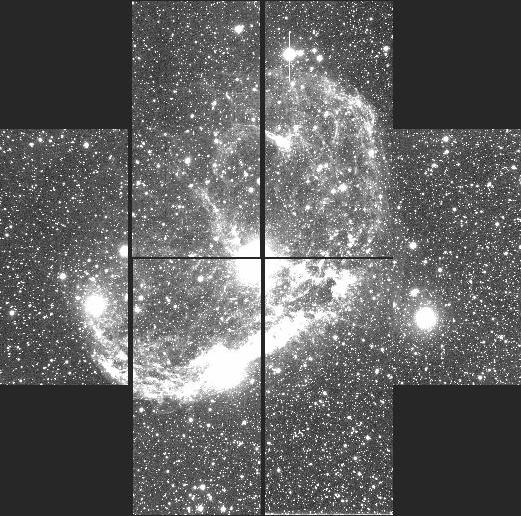
Next, we zoom in to the brightest star-forming association in the Andromeda Galaxy, NGC 206. Myriads of giant and supergiant stars are resolved on this single CCD.

Palomar is also noted for the 1.2-meter Oschin Schmidt telescope (formerly the 48-inch, Big Schmidt, or P048). It gained fame with the Palomar Sky Survey in the 1950s, followed by use for very deep galaxy imaging using careful photographic processing by Arp and Lorre. In its new digital incarnation with the enormous QUEST mosaic of CCD chips, it plunged the astronomical community into furious debate with the discovery of 2003 UB 313 (AKA Xena AKA Eris).

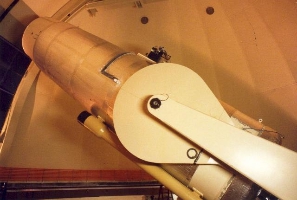
The Big Schmidt had a predecessor, Fritz Zwicky's 18-inch Schmidt. With this instrument, he carried out the first large-scale searches for supernovae, doing much to put our knowledge of these explosions on a systematic footing. The 18-inch has seen little use in many years, and its site is being discussed for replacement.
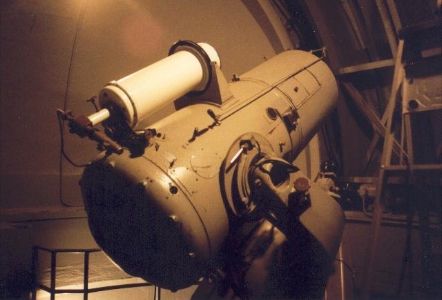
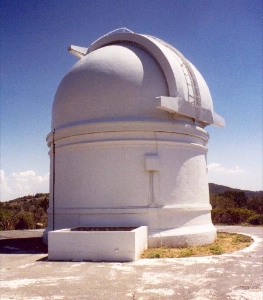
Palomar also hosts the 1.5-meter Oscar Meyer telescope. It has recently been automated for rapid followup of such events as gamma-ray bursts. Like the 1.2-meter Schmidt, its tube has been covered with high-emissivity foil to bring it to thermal equilibrium rapidly. (By the way, special thanks to Scott Kardel for letting me in to get the shots of the 48- and 60-inch telescopes).

Newest of the instruments at Palomar is the Palomar Testbed Interferometer (PTI), which is being used to refine techniques in optical and infrared interferometry. These developments point toward the day when we can use these techniques to study stars at unprecedented angular resolution, detect planets by their astrometric pertubations of stellar motions, and, perhaps, produce images of extrasolar planets by using cancellation of waveforms to reduce the glare of the central stars.
Palomar used to be one of the "greatest hits" at the Terraserver site, in the picture reproduced below since it's a USGS image allowing such use. (The old direct link quit working - here's a Google Maps satellite image. That is a nice big dome, often used by B-52 pilots as a landmark to line up for nocturnal approaches at a nearby Air Force base. There are some really amusing Schmidt plates from here showing the autoguiders trying to lock onto aircraft. Note the white paint on the driveway near the dome, as done for the Cerro Tololo 4-m Blanco telescope, to improve seeing by keeping it from absorbing the usual amount of sunlight during the day.

Last changes: 04/2007 © 2001-2007